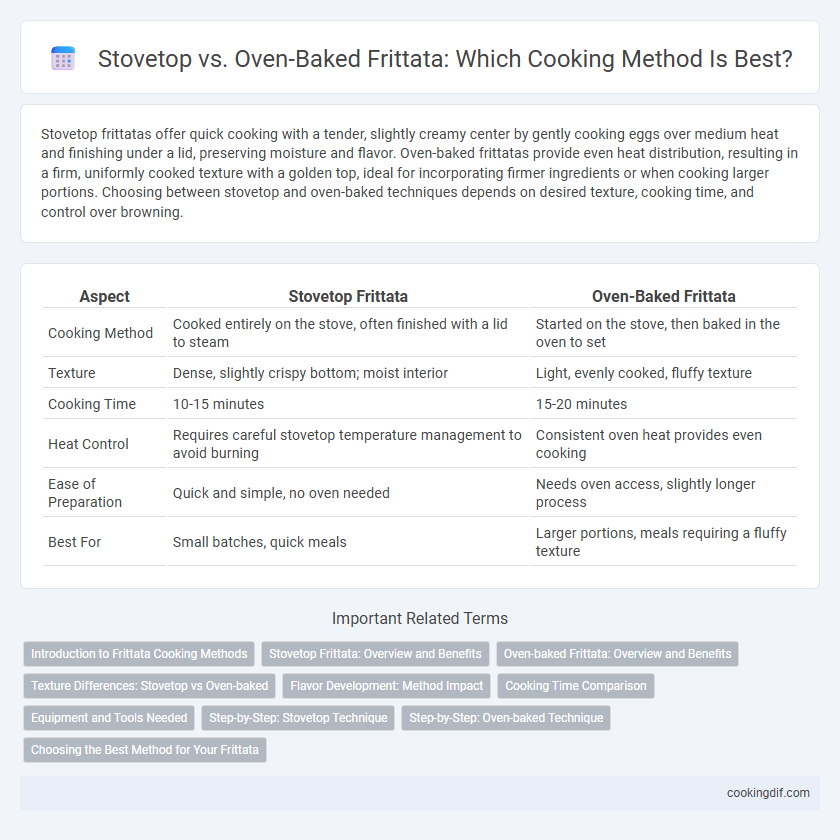Stovetop frittatas offer quick cooking with a tender, slightly creamy center by gently cooking eggs over medium heat and finishing under a lid, preserving moisture and flavor. Oven-baked frittatas provide even heat distribution, resulting in a firm, uniformly cooked texture with a golden top, ideal for incorporating firmer ingredients or when cooking larger portions. Choosing between stovetop and oven-baked techniques depends on desired texture, cooking time, and control over browning.
Table of Comparison
| Aspect | Stovetop Frittata | Oven-Baked Frittata |
|---|---|---|
| Cooking Method | Cooked entirely on the stove, often finished with a lid to steam | Started on the stove, then baked in the oven to set |
| Texture | Dense, slightly crispy bottom; moist interior | Light, evenly cooked, fluffy texture |
| Cooking Time | 10-15 minutes | 15-20 minutes |
| Heat Control | Requires careful stovetop temperature management to avoid burning | Consistent oven heat provides even cooking |
| Ease of Preparation | Quick and simple, no oven needed | Needs oven access, slightly longer process |
| Best For | Small batches, quick meals | Larger portions, meals requiring a fluffy texture |
Introduction to Frittata Cooking Methods
Frittatas can be prepared using stovetop or oven-baked methods, each offering distinct textures and flavors. The stovetop technique involves gently cooking the eggs on medium heat, allowing for a tender, custard-like consistency with a slightly crispy bottom. Oven-baking ensures even cooking throughout and creates a firm, fully set frittata with a golden top, ideal for serving larger portions.
Stovetop Frittata: Overview and Benefits
Stovetop frittatas offer a quick and versatile cooking method that enables even heat distribution and easy monitoring during the cooking process. This technique preserves the frittata's creamy texture by cooking it gently and avoiding the dry edges often caused by oven-baking. The stovetop method also allows for greater control over ingredient incorporation and reduces overall cooking time, making it ideal for busy kitchens.
Oven-baked Frittata: Overview and Benefits
Oven-baked frittatas provide even heat distribution, ensuring a consistent texture and fully cooked eggs without the risk of burning the bottom. This technique allows for a thicker, fluffier frittata with uniform browning on top, which stovetop methods often lack. Baking also offers hands-off convenience, freeing the cook to prepare other dishes while the frittata cooks slowly and evenly.
Texture Differences: Stovetop vs Oven-baked
Stovetop frittatas develop a creamier, custard-like texture with softer edges due to gentle, direct heat and frequent stirring, preserving moisture within the eggs. Oven-baked frittatas feature a firmer, more uniform texture and slightly browned, crispy edges from even heat circulation, ideal for holding added vegetables or cheese in place. Choosing between stovetop and oven-baking influences the final frittata's mouthfeel and structural integrity, affecting pairings and serving style.
Flavor Development: Method Impact
Stovetop frittatas develop a rich, caramelized crust due to direct heat, enhancing Maillard reactions and intensifying savory flavors. Oven-baked frittatas cook more evenly with gentle heat, preserving delicate herbs and producing a tender, custard-like texture without excessive browning. The choice between stovetop and oven significantly influences flavor complexity and texture, catering to distinct culinary preferences.
Cooking Time Comparison
Stovetop frittatas typically cook faster, usually taking around 10-15 minutes, as the heat directly reaches the eggs from below. Oven-baked frittatas require a longer cooking time, often 20-25 minutes, allowing for even heat distribution and thorough cooking. The stovetop method offers quicker results, while oven baking provides a more uniform texture throughout the dish.
Equipment and Tools Needed
Stovetop frittatas require a heavy, oven-safe skillet such as cast iron to ensure even heat distribution and easy transition from stove to heat source. For oven-baked frittatas, a non-stick or ceramic baking dish with good heat conductivity is essential for consistent cooking and effortless release. Essential tools include a silicone spatula for stirring and folding ingredients, and an oven mitt for safe handling of hot cookware.
Step-by-Step: Stovetop Technique
Heat a non-stick skillet over medium heat and add a small amount of olive oil or butter to prevent sticking. Pour in the beaten eggs mixed with your choice of vegetables, meats, or cheese, cooking gently without stirring to allow the edges to set. Once the edges are firm and the center begins to thicken, reduce the heat to low, cover the skillet with a lid, and cook until the frittata is fully set and cooked through, usually about 8 to 10 minutes.
Step-by-Step: Oven-baked Technique
Preheat the oven to 350degF (175degC) and prepare an oven-safe skillet by lightly greasing it with oil or butter. Whisk eggs with your choice of ingredients, pour the mixture into the skillet, and bake for 15-20 minutes or until the eggs are set and lightly golden on top. Allow the frittata to cool for a few minutes before slicing to ensure even texture and ease of serving.
Choosing the Best Method for Your Frittata
Stovetop frittatas offer quick cooking and a tender, evenly cooked interior, ideal for a fast breakfast or small portions. Oven-baked frittatas provide a consistent temperature, allowing for a fluffy texture and perfect browning, suitable for larger servings or meal prep. Selecting the best method depends on your time constraints, desired texture, and portion size.
Stovetop vs Oven-baked for Frittata technique Infographic

 cookingdif.com
cookingdif.com